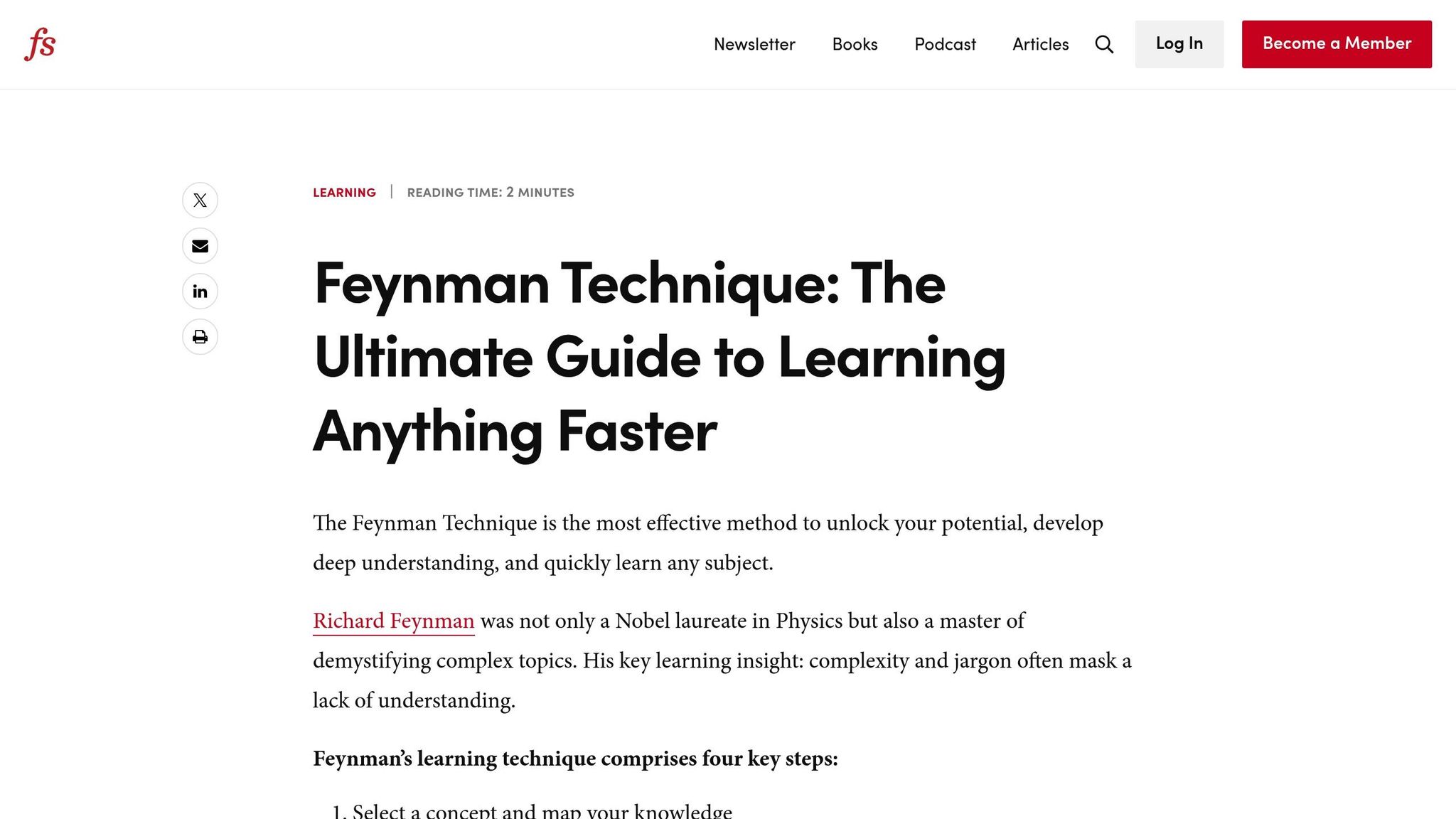How to Explain Complex Ideas in Simple Language
Explaining difficult concepts in simple language doesn’t have to be hard. It’s about breaking things down, using plain language, and connecting ideas to everyday experiences. Here’s how you can do it:
- Simplify with the Feynman Method: Explain as if teaching a beginner. Write it out, identify gaps, and simplify further.
- Use Comparisons: Relate ideas to familiar things (e.g., “Cloud storage is like a digital locker”).
- Avoid Jargon: Replace technical terms with common words (e.g., “optimize” becomes “improve”).
- Break It Down: Divide big ideas into smaller steps or parts.
- Know Your Audience: Tailor your language to their knowledge and background.
- Edit for Clarity: Use short sentences, simple words, and clear examples.
Tools like BeLikeNative can help simplify text further, especially for multilingual audiences. Clear communication saves time, reduces confusion, and improves understanding – whether you’re explaining a product, writing documentation, or working with global teams.
How to Explain Complex Topics (with examples) In Simple Language?
Methods to Express Complex Ideas In Simple Language
Turn tough concepts into clear, easy-to-understand explanations using practical techniques.
The Feynman Method: Teach to Learn

This method, named after Nobel Prize-winning physicist Richard Feynman, focuses on explaining ideas as if you’re teaching them to someone new. Here’s how to use it:
- Pick a complex topic.
- Write it out in simple terms.
- Identify and fix any gaps in your understanding.
- Review and simplify further.
For example, instead of saying, “The algorithm utilizes machine learning to optimize content delivery”, you could say, “The system learns from past data, like a student improving with practice, to share information more effectively.”
Compare Ideas to Everyday Things
Relating concepts to familiar experiences can make them easier to grasp. For instance, when explaining cloud storage to someone unfamiliar with it, you might say it’s like a virtual storage unit where you keep your digital belongings and can access them anytime, anywhere with an internet connection.
Here are some helpful comparisons:
- DNA works like a recipe book filled with instructions for creating living things.
- Computer RAM is like a desk where you keep items you’re actively using.
- Blockchain functions like a shared digital ledger that everyone can see but can’t change without agreement.
Use Plain Words Instead of Jargon
Swap out technical terms for simple language while keeping the meaning intact. For example:
Instead of: “The implementation of this methodology facilitates enhanced productivity through streamlined processes.”
Use: “This method helps people work better by simplifying tasks.”
Once you’ve simplified the language, divide big ideas into smaller, easier-to-understand parts.
Break Big Ideas into Smaller Steps
Breaking down large concepts into smaller, connected parts makes them easier to understand. For example, to explain how a car engine works, you could break it into:
- Fuel System: The engine’s source of energy.
- Combustion Process: How fuel is turned into power.
- Power Transfer: How that power moves to the wheels.
Simplification doesn’t mean oversimplifying. The goal is to make your explanations clear and accurate, acting as a bridge between your audience’s current knowledge and what they need to learn. Tools like BeLikeNative can help make this process smoother.
Steps to Write More Clearly In Simple Language
Know Who You’re Writing For
Understand your audience by considering:
- Their technical expertise
- Industry experience
- Reading habits
- Language skills
For example, if your audience includes non-native English speakers, stick to simple vocabulary and straightforward sentences. Avoid idioms, regional phrases, or complex metaphors that might confuse them. Once you have a clear picture of your readers, focus on organizing your content effectively.
Order Your Ideas Well
A logical flow helps readers navigate complex topics. Start with:
- Core concept: Introduce the main idea upfront.
- Supporting details: Add context and examples to back it up.
- Advanced information: Include deeper insights for those who want more.
Use headings and subheadings to make your content easy to scan. A clear structure ensures readers can quickly find what they’re looking for. After organizing your ideas, the next step is to simplify your writing through editing.
Edit for Simplicity
Editing sharpens your message and makes it easier to understand. Here’s how to do it:
- Streamline structure and flow:
- Combine related ideas
- Cut out redundant information
- Ensure everything flows logically
- Improve readability:
- Shorten sentences
- Use simpler words
- Avoid unnecessary jargon
- Polish clarity:
- Read your work aloud to catch awkward phrasing
- Keep terminology consistent
- Double-check examples for relevance
Here’s an example of simplifying text:
Original: “The implementation of the methodology necessitates careful consideration of various contingencies to ensure optimal outcomes.”
Simplified: “Pick the right method by thinking about possible challenges and how to get the best results.”
Simplifying doesn’t mean dumbing down. The goal is to make your ideas clear and accessible while keeping their full meaning. Every word and sentence should have a purpose, so edit with precision.
sbb-itb-32359dc
Writing Tools That Help Writing In Simple Language
Once you’ve mastered manual techniques, digital tools can make it easier to simplify and clarify complex ideas. These tools are designed to help make your text more understandable.
Using BeLikeNative To Write In Simple Language

BeLikeNative is a Chrome extension that simplifies complicated text while keeping the original meaning intact. It’s especially useful for tackling complex topics or working across different languages.
Here’s how BeLikeNative can make writing easier:
- Instant Text Simplification: Highlight your text, use a shortcut, and get a simplified version with consistent terminology. It works smoothly on popular platforms.
- Supports 80+ Languages: Adjust the tone, style, and audience level to suit your needs.
BeLikeNative offers several pricing options:
| Plan | Monthly Cost | Daily Usage Limit | Character Limit |
|---|---|---|---|
| Explorer | Free | 25 uses | 1,000 |
| Learner | $4 | 50 uses | 4,000 |
| Native | $6 | 125 uses | 6,000 |
| Premium | $14 | 180 uses | 10,000 |
This tool is particularly helpful for tasks like:
- Breaking down technical concepts for non-experts
- Communicating with non-native English speakers
- Simplifying academic writing
- Creating content for multilingual audiences
Real Examples of Writing In Simple Language
Here are some real-life examples showing how to turn complicated text into clear, easy-to-understand language.
Simplifying Complex Sentences
Take a look at how these sentences were rewritten for clarity:
Original: “The implementation of cross-functional methodologies necessitates the parallel integration of functionally separated organizational entities to facilitate optimal resource allocation and maximize operational efficiency.”
Simplified: “Teams from different departments need to work together to share resources and improve results.”
Here’s another example from a legal document:
Original: “The party of the first part hereby acknowledges and agrees that any and all intellectual property rights, including but not limited to patents, trademarks, and copyrights, shall remain the sole and exclusive property of the party of the second part.”
Simplified: “You agree that we own all rights to our patents, trademarks, and copyrights.”
Breaking Down Technical Concepts with Examples
Using relatable comparisons can make technical ideas easier to grasp. Here are a couple of examples:
Cloud Storage
- Original: “A distributed computing architecture that enables data persistence across multiple virtual instances.”
- Simple: “Cloud storage is like a digital locker you can access from anywhere. It’s secure and easy to open with your phone.”
Machine Learning
- Original: “An algorithmic approach to pattern recognition and data analysis that enables systems to iteratively improve performance without explicit programming.”
- Simple: “Teaching a computer to learn is like teaching a child to spot dogs. First, you show them lots of pictures of dogs, and over time, they figure it out on their own.”
Translating Technical Terms to Plain Language
Here’s how technical jargon can be replaced with simpler terms:
| Technical Term | Plain Language |
|---|---|
| Utilize | Use |
| Implement | Put in place |
| Facilitate | Help |
| Optimize | Improve |
| Leverage | Use |
To simplify writing, focus on:
- Using common, everyday words
- Breaking long sentences into shorter ones
- Including relatable examples
- Cutting out unnecessary jargon
These techniques make your writing easier to understand and more engaging for a wider audience.
Writing for Different Regions
Adjusting content to fit regional formats is essential for effective communication. These adjustments ensure your message is clear and easy to understand, no matter the audience.
Dates and Times
Date formats differ by region, which can lead to misunderstandings:
- US format: April 4, 2025 (MM/DD/YYYY)
- UK format: 4 April 2025 (DD/MM/YYYY)
- ISO format: 2025-04-04 (YYYY-MM-DD)
To minimize confusion, write dates in full. For global audiences, the ISO format is a reliable choice to avoid ambiguity.
Numbers and Measurements
Number formatting also varies widely across regions:
| Region | Large Number | Decimal |
|---|---|---|
| US | 1,000,000.50 | 3.14 |
| Many European | 1.000.000,50 | 3,14 |
| Indian | 10,00,000.50 | 3.14 |
For measurements, include both imperial and metric units to cater to different preferences (e.g., 86°F [30°C] and 6.6 lbs [3 kg]).
Currency
When mentioning prices, always include the currency symbol. For international readers, consider adding conversions:
- US: $499.99
- International: USD 499.99 or $499.99 USD
Language and Writing Standards
Beyond formatting, tailor your tone and examples to fit local expectations:
- Avoid regional idioms and stick to universally understood terms.
- Use clear, direct sentences.
- Break down complex ideas with simple examples that resonate globally.
- US readers often prefer active voice and straightforward statements.
- Some regions may lean toward more formal, indirect communication styles.
- Adapt technical terms to align with local industry norms.
- Use examples that reflect local contexts and measurement systems.
Digital tools can simplify regional adjustments. For instance, BeLikeNative supports writing in over 80 languages, ensuring your content stays clear and relevant across different regions. These adjustments work hand-in-hand with strategies for simplifying complex topics.
Conclusion: Making Complex Ideas Clear
Clear communication is essential for achieving results. Professionals who prioritize clarity often see improvements in both workflow efficiency and overall understanding.
By removing unnecessary complexity, we make it easier for others to learn and retain information. This is especially important in professional environments, where clear communication can be the difference between a successful project and costly mistakes. Modern tools play a big role in supporting this clarity.
Today’s writing tools have changed how we handle complicated topics. For instance, users of BeLikeNative have reported a 66% boost in productivity. These gains come from features that help writers:
- Simplify complex language for easier understanding
- Tailor content for various regional audiences
- Ensure consistent tone and style across projects
- Speed up the writing process with built-in shortcuts
These tools show how technology can make simplifying ideas easier and more effective.
Explaining complex ideas successfully means combining proven methods with tools that balance technical precision and accessibility. As BeLikeNative.com highlights:
“Unlock a world of efficiency, clarity, and simplicity”


